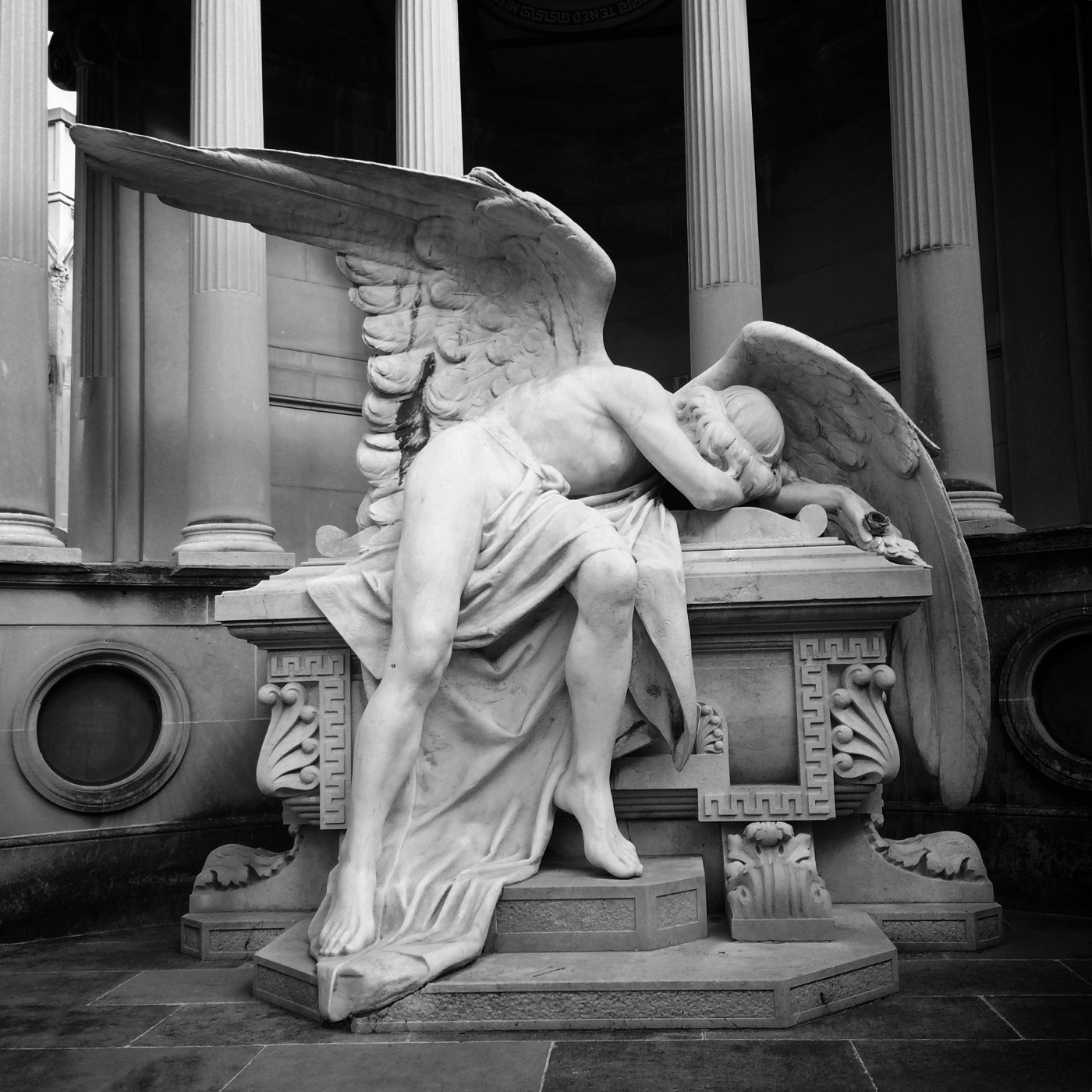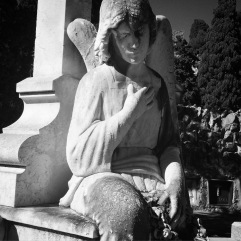Wow wow wow. This place is amazing. I don’t why this isn’t considered a major tourist attraction, the funerary art and architecture here is stunning. It hits you right as you enter the main gate at the bottom of the hill, and continues right to the top of the mountain, where you will have stunning 360 degree views of the sea and the city. This cemetery was where the well-to-do built their elaborate tombs and mausoleums, commissioning renowned architects, sculptors, and stained glass artists to create their final, family monuments. I didn’t notice any office or map as I entered, but there were signs pointing to historic and artistic sections, although I’m not sure how or why they were different, since the artistic sections were historic, and vice versa. Many of the notable tombs and sculptures have information panels in front of them, with qr codes for extra information.
So the cemetery is literally on the side of a mountain, facing the sea. The cemetery goes right to the top and then back down the other side, but the graves on the landward side are much newer. Since the cemetery mostly goes up, you should walk from one end to the other before making your way up to a higher level. I learned this the hard way, as I thought I had gone most of the way along the bottom, but I didn’t. And I ended up missing the most amazing section of the cemetery as a result. Well, I saw it on the way down, but by then the light and time was against me, as I was racing to photograph as much as I could, even in the failing light, before they closed the gates at 6 p.m. there were so many amazing statues I could have done just landscape shots and gotten at least five in one frame. I can’t think of any other cemetery that matches the grandeur of these monuments, other than Staglieno, which shares a similar type of terrain, being situated on a hillside. I will definitely find some time to return here before I leave the city, just so I can revisit that beautiful section without being in such a rush.
There are long, loping roads that wind their way up the mountain, but there are multiple stairs that provide shortcuts up to various sections, which is how I explored the cemetery. Which is also how I missed the good part, until the very end, although I will admit that when I started it seemed easier to do go up one side (the western half) and go down the other side (the eastern half). That is what I ended up doing, because that’s how I tend to explore cemeteries anyway – work my way around the edges to the centre, even though the centre is what is likely to have all the good stuff (save the best for last). Even though I keep mentioning the good part, the reality is, is that this is an amazing cemetery to visit, every part of it. Even the wall niche sections are interesting in their overwhelming majority, with very old panels mixed in with very new. Seeing the seagulls ride the drafts as you move up the cemetery. The smell of roses everywhere you go. And coming across beautiful statues when you least expect it. They were everywhere. Angels, of course, were a popular subject, but there were also a fair number of more secular models as well, and more skulls (and skeletons) that I expected – in fact, I would love to have time to explore the cemetery in a more leisurely fashion, just to look for those smaller details. As it was, I was here for over 4 hours and that was not nearly enough time – I think 6 probably would have been better, considering the rush I was in at the end.
Barcelona already had a large cemetery at Poble Nou, but by the mid- to late- 19th century the city was booming and it became obvious that another cemetery was needed. That cemetery was place on the steep sides of Montjuïc. At the same that the city developed, a lot of artistic movements were developing as well, with the classic and Gothic styles popular in other cemeteries of this time period, but also Art Nouveau and Catalan Modernisme (i.e. Gaudi). All those styles are well-repesented in the cemetery.
What I really liked about the cemetery was how well-integrated the design of the place was. The stairs went up in different ways, some had weird rock formations overhead (very Gaudi-like), but all were made up the same stone that makes up the walls and niches of the cemetery. As you went up in height, you also would come across years written on the stairs, indicating (I think) when that section was built. In between many of the gravesites were benches. Not stand-alone benches, but benches made right in the walls, of the same stones. They were everywhere. Every little space that couldn’t fit a grave had a bench. As you know, benches are something I always look for, especially in larger cemeteries, as it’s nice to be able to have a place to sit and rest and contemplate life (or death), but so few cemeteries really have them. The cemetery cats (there are always cats) seemed to love sunning themselves on the warm stones that made up this cemetery.
The only downside to this cemetery is that it is not that easy to get to. I walked down the mountain (from Poble Espanol, where I had spent the morning/lunch), but that was a 45-minute walk. And in the end, it took about an hour for me to get back to the metro station, as you have to walk around the mountain (there’s nothing on the sea side). Now, there is a bus that goes by there (#21), but not often. That said, I’m not complaining. Over 30,000 steps and 100 staircases today! I have to say though, despite all the stairs, I didn’t find it strenuous to get around at all. That said, I might have a different viewpoint about that in the middle of summer!
If you are in Barcelona, go, go, go to Montjuïc – it should be on everyone’s cemetery bucket list (does anyone have one of those?) Spanish cemeteries never seem to make it into anyone’s “top 10” (or 20) most interesting/beautiful cemeteries list, (probably because most journalists just repeat what everyone else says, without having visited any of the cemeteries they are writing about*), but it should. Not that I rank cemeteries, but out of all the ones I’ve been to so far (115), this is definitely in the top 3.
*I just had a quick look at about 8 different articles I’ve bookmarked about “the best/most beautiful/most interesting” cemeteries to visit around the world and not one mentions any Spanish cemetery. I’ll have to do a more thorough investigation about that and report back on that in another post.
____________________________
Monuments: Outstanding. The statues and architecture of the mausolea and tombs here are stunning. This really is an outdoor art museum, with pieces to catch your eye everywhere you turn.
Grounds: The mountainside is quite steep, but you can get up to the top by car on the paved roads, or by taking any of the numerous stairs that cut through the paths on your way to the top. I’m sure there must be an office and/or facilities (toilets) around, but I never saw any, or a sign to any. Bring water, especially in hot weather, and possibly a hat or umbrella to keep the sun off. It can get really windy since you are right beside the water so a hat (or ponytail) will help keep your hair from blowing in your face. That said, the view from the top is really worth it, and simply jaw-dropping at times.
Visitors: There was a young couple with a baby wandering around when I was here, but aside from them, most other people I saw (not many) were maintenance people or mourners (but the latter came and went quickly in their cars). A funeral procession did pass me by on my way in but I never came across it later in my explorations.
Notes: Bring lots of film (if you use it like me) or make sure you have enough storage on your card for your digital camera. Since the cemetery faces south, the sun passes overhead from east to west, combine with the tall trees and walls here, can make for some harsh (or flattering) contrasty (or artistic) lighting. You may want to use fill flash to deal with backlight and uneven lighting, or come on a cloudy day to get more even light.
DETAILS
Cemetery: Cementiri del Sud-oest or Cementiri de Montjuïc
Established: 1883
Notable Internments: Over 1,000,000 internments and 150,000 graves here. Some notable people include Ildefons Cerdà (architect), Isaac Albeniz (musician and composer), Joan Gamper (founder of FC Barcelona), Joan Miro (painter and sculptor), Francesc de Paula Rius i Taulet (mayor of 4 different terms), Enriqueta Martí i Ripollés (possibly one of Spain’s worst serial killers, she was a procurer of children, kidnapper, and witch doctor (her story is quite disturbing) – after being lynched by her fellow prison mates while awaiting trial for her crimes, she was buried in a common grave here).
Location: Mare de Déu del Port. The closest metro stop is Paral-lel, or possibly Drassanes. From there you could take Bus 21. Taxi/Uber would be another option. After my visit, I walked back to Espanya, which was a bit longer, but it was nice to stretch out the legs after all the up and down climbing.
Edit: On my second visit I did walk from Paral-lel along the port side, but I don’t recommend it. I took bus 21 back, which was fast and easy to do (it runs every half hour around 20- and 50-past the hour).
Hours: 08:00-18:00. Make sure you are close to the entrance by the time it closes (aka near the bottom) since it can take longer than you think to meander down all those stairs, which are not in a straight line (you’ll be zigzagging your way down, regardless if you take the roads or the stairs).










































March 21, 2018 at 19:10
Thanks for this write-up. This does appear to be a most impressive cemetery., It is surprising that there are no Spanish cemeteries on others’ best cemetery lists. But, that is all subjective after all.
City planners often overlook the need for future (as in “before need”) cemetery space. Back in previous centuries, there was not nearly as much planning as many cities sort of grew helter skelter into any nearby available land.
Have to love those cats! Thanks again for this post – it was very informative.
LikeLiked by 1 person
March 21, 2018 at 19:18
Reblogged this on larrysmusings and commented:
Today, we reblog an interesting post on a large cemetery in Spain. Have you ever visited a cemetery while on holiday or vacation? (Considering our shared mortality, gives us pause to assess or reassess our life values.) Many such places offer quite artistic sculpture and beautifully kept grounds. As well, Rachelle captures images in black and white which gives interesting photographic effects.
LikeLike